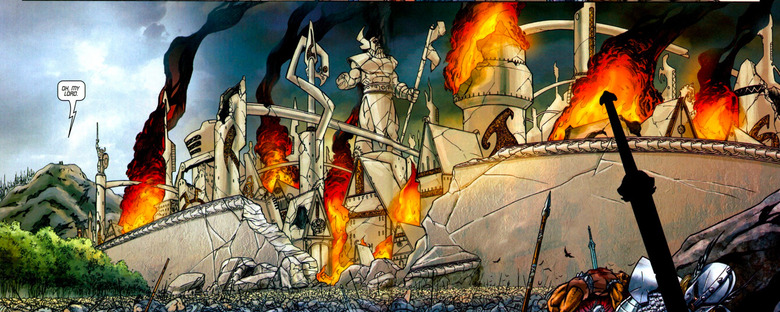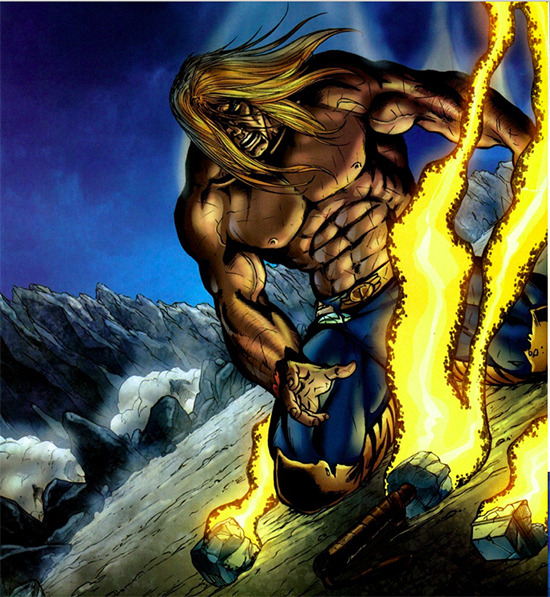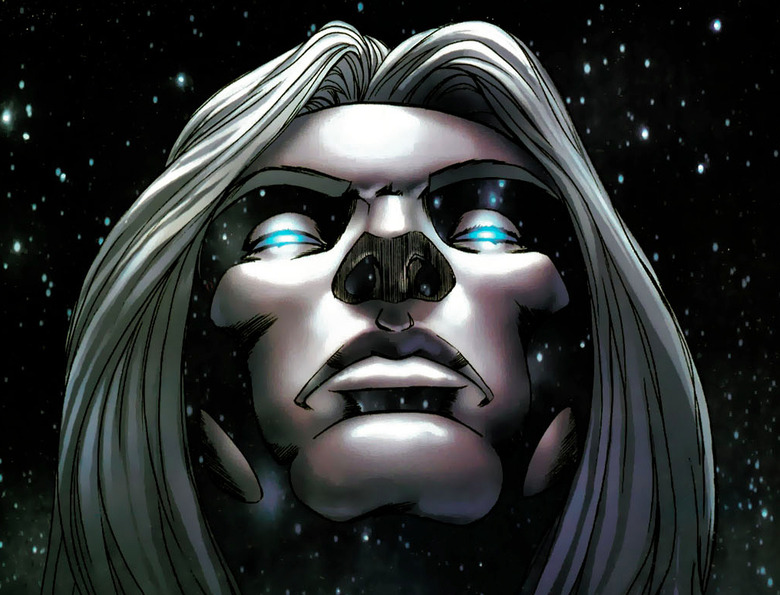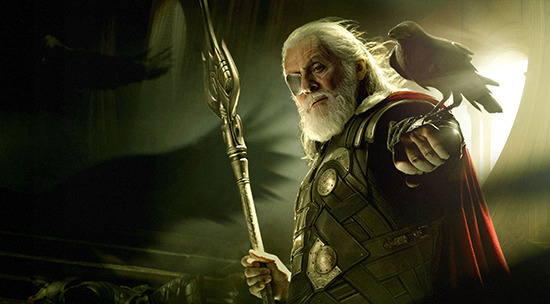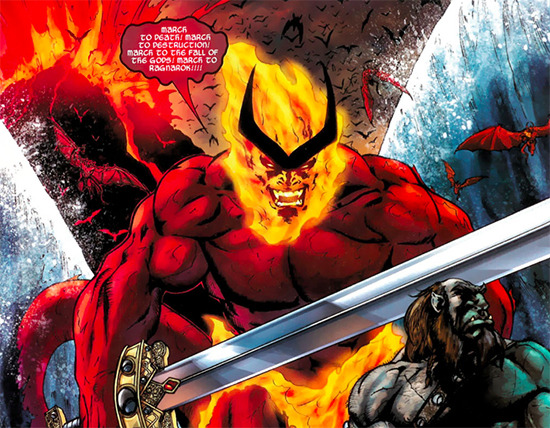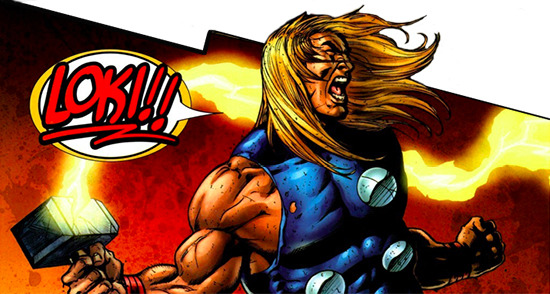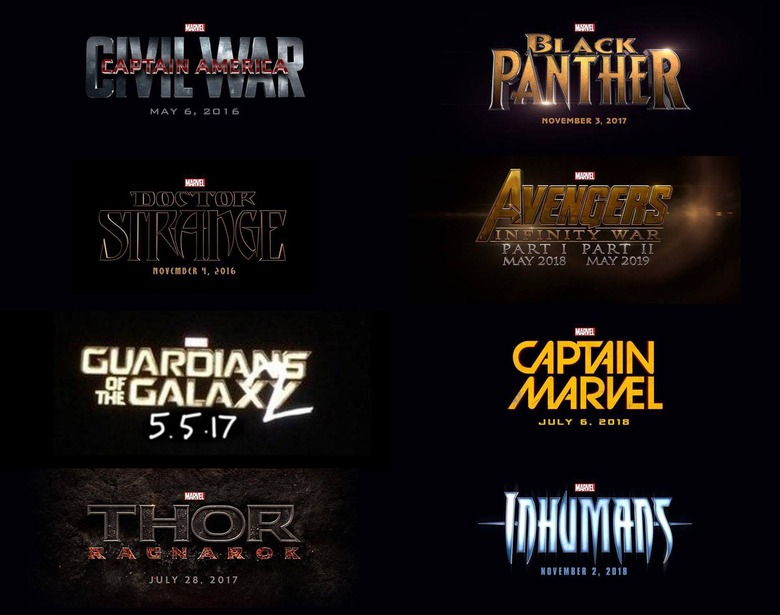What Is 'Thor: Ragnarok'? How Marvel's Phase Three Movie Will Shake Asgard
Dead gods, cyborg clones, and the end of Asgard — Ragnarok could be a big deal. Marvel recently announced that the third Thor movie, Thor: Ragnarok, is due for release in July 2017, with Chris Hemsworth and Tom Hiddleston returning to reprise their roles of Thor and Loki. But what is Thor: Ragnarok, exactly?
"This is a very important movie for us in Phase 3," said Marvel's Kevin Feige when announcing the movie. "We plan on taking Thor to another level. It picks up where we leave Thor in 'Avengers: Age of Ultron' and impacts everything that comes after."
So what are the events that will impact Thor and Asgard, and impact the rest of the Marvel Cinematic Universe going forward into Phase 3? A couple different comics storylines give us some big hints. Below, we'll explore Thor: Ragnarok in detail.
Note that there are many spoilers here for various comic book stories, and also for Thor: The Dark World.
There's also a healthy amount of speculation below. We know that Thor shows up in Avengers: Age of Ultron, and we know that Heimdall (Idris Elba) and Loki (Tom Hiddleston) also make an appearance. We don't know if Thor will show up again until Ragnarok, and given that Hemsworth only has a couple more films in his contract after Age of Ultron, Marvel may need to make them count.
***
What Is Marvel's Version of Ragnarok?
This is pretty complicated, as many modern Marvel stories tend to be. Ragnarok has come and gone from Asgard multiple times, but for our purposes the most recent iteration seems like the most important. The backstory features Thor inheriting the Odinpower after Odin basically dies during a battle with the fire demon Surtur. Puffed up with this power, Thor goes a little bit crazy, extending the rule of Asgard to rule of Earth, and spends a couple hundred years as an all-powerful and not-at-all cool deity. Eventually he basically said "oops!" and traveled back in time to wipe out that whole storyline.
So, as Thor gets back to Asgard, a variation on the quest from Lord of the Rings is playing out. The mold that created Mjolnir still exists, and could potentially be used to make other serious weapons. The dwarves who originally forged Mjolnir are carrying the mold around, seeking to throw it into the void between worlds. They nearly succeed, but Loki intercepts the mold. Loki has new weapons made, and with a force of powerful allies he attacks Thor and friends. In the first attack Mjolnir is broken, and the subsequent war basically destroys Asgard.
What Does Ragnarok Mean for Thor?
Possession of the Mjolnir mold and the weapons spawned from it gives Loki an almost impossible advantage over all other Asgardians, and he's also got Surtur on his side. So Thor goes in search of a greater power: the full wisdom of Odin. That's not so easily attained, however. To get it Thor plucks out both eyes and ultimately hangs himself from Yggdrasil, the world tree, to attain the full wisdom of his father.
Thor learns that a set of powerful beings, Those Who Sit Above in Shadow, have manipulated the Ragnarok cycle for aeons, feeding off the energy it creates. By causing the cycle to repeat over and over, Those Who Sit have cheapened and debased the sacrifices and achievements of Asgardians, essentially keeping them from their glorious deaths. Thor seeks to break the cycle, and to do so must sacrifice himself.
Just Be Honest -- Does Thor Die Here, Or Not?
Yeah, he does. Well, kinda. Maybe? OK, not really. His actions kind of destroy all of Asgard, and leave him technically in limbo, basically floating in a void. Keep in mind that the Marvel Comics version of Thor is much more dependent upon the idea that Thor is occasionally bound to a human man, too, and that ends up being the key to his escape from the void. So he comes back in the comic stories, but there's a pretty good story set up to kill off Thor. Or at least this version of him.
***
Now that we've set out some comic-based background, let's get into some other details about an alternate Thor, the Odin of the MCU, and other characters who could appear.
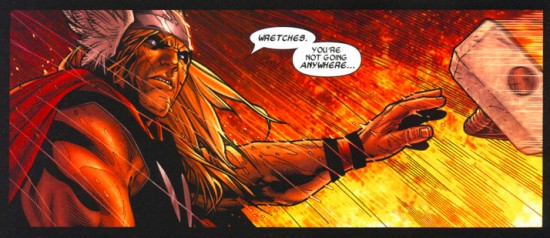
The problem with using the word "Ragnarok" in the context of Marvel Comics isn't just that it is both a piece of real-world lore and something that has been used more than once as a device in comic story arcs. It's also a person. Well, a thing that is almost a person. And that's a good entry point into some character questions.
Isn't There Another Ragnarok?
Indeed there is. During the Civil War storyline in 2006, Thor was missing in action due to the events of the Ragnarok story mentioned above. When he was in limbo, the rest of the Avengers had no idea what was going on with Thor. But this is comics, and that's no reason not to feature the guy.
For Civil War, Mark Millar and Steve Mcniven crafted a storyline in which Tony Stark reveals a hair of Thor he has kept around for emergencies — not creepy at all, Tony — and which is then used to clone the Thunder God. But this isn't just a clone of Thor. Stark, working in concert with Reed Richards and a Skrull masquerading as Hank Pym (that's a whole other story), creates a cyborg Thor clone, which beats the crap out of heroes opposing the registration act. Cyborg Thor kicks around the Marvel Universe for a while, eventually taking on the name Ragnarok, experiencing destruction and recreation a couple times.
So... Where's Odin?
This is an interesting question, because we don't know what's happening with Odin right now in the MCU. Thor: The Dark World ends with Loki having assumed Odin's form, but we don't know where Odin actually is. When the film was released, Kevin Feige said "Like all of our plans at Marvel Studios, we know where we would like to go if given the opportunity. We have very good ideas, whether the All-Father is with us or not."
And Anthony Hopkins, who played Odin in the first two movies, has added in a somewhat joking tone, "Maybe he's dead. I've done two, that's enough."
Odin being dead could open up an opportunity for Thor to take Odin's power, and in so doing lead towards one of a couple of the comic book storylines mentioned above. But that seems like a big assumption to make. Regardless, "what happened to Odin?" is going to be one of the big questions for a Thor sequel.
What Other Characters Could Show Up?
There are two primary characters who could show up in the third Thor film. One is almost a certainty, while the other is possible, but far less likely.
The next obvious foes for Thor to fight, since he's already kicked ass from a few of the nine realms, would include the Fire Demons of Muspelheim. Among those fire demons is Surtur, who as mentioned above (a) takes out Odin in one comics story and (b) is a big part of Ragnarok. Loki is a motivator for that whole "stealing the mold of Mjolnir" story, but Surtur is the muscle, the war machine.
And then there's Beta Ray Bill. Like so many big Marvel Comics storylines, the six issues of Ragnarok feature a giant cast of characters that will probably never show up in the films. Beta Ray Bill, the alien with the horse-skull face who wields a Mjolnir-like hammer, is a big part of the comic book story, but it's probably too much to hope that he'll show up. (He could always be introduced in Guardians of the Galaxy 2, but that doesn't seem like the sort of thing that film has in mind, from what little we know.)
Bill's story is pretty big — it would be a shame to shoehorn him in as a mere supporting character, and so we don't expect him to be around this time, if he shows up in the MCU at all. (We'd love to be surprised on this point.)
***
OK, finally, with all those situations and characters laid out, How Does This All Fit Into the Marvel Cinematic Universe?
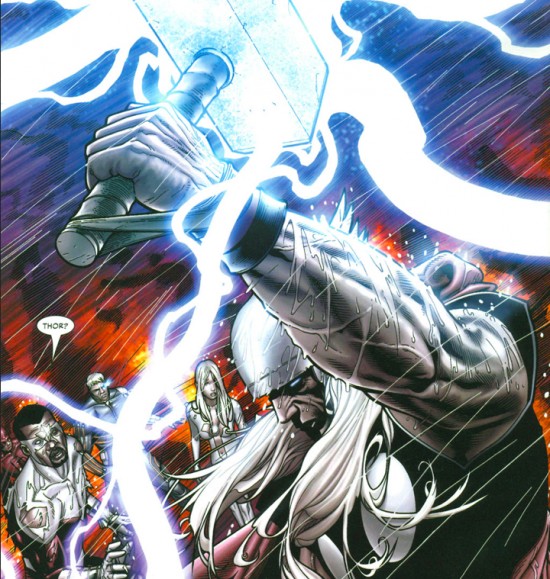
Now that we've laid out a bunch of story and character background, let's see how we can put it together into something that makes sense for the Marvel Cinematic Universe.
How Does Chris Hemsworth's Contract Factor In?
As fun as it would be, we're probably not going to see Cyborg Thor show up in Civil War. Why not? Marvel may not have the leeway to bring Thor in. Clearly that film is primarily going to center on Tony Stark, Captain America, and Chadwick Boseman's Black Panther. And once Age of Ultron is out, Hemsworth will have fulfilled four films on his six-film contract. (When promoting The Dark World he specified that he was set for one more Thor movie and two more Avengers, which would presumably include Age of Ultron.)
All of which means that there won't be any way to set up some of the big elements of the comic book storylines without burning one of Hemsworth's remaining films. As Marvel goes forward, it will have to gauge the actor's interests to figure out how to develop the stories in films his contract does cover, in the event he doesn't want to re-up (or stipulates terms Marvel won't match).
On comics pages, we've seen big character shifts occur when sales need to be goosed, or when creative teams change over. We might soon start to see whether or not contractual issues will be the leverage that forces big character shifts on screen.
So What Elements of Ragnarok Will Hit the Screen?
At this point all we can really bank on is that Ragnarok will represent a giant problem for Asgard, and that Loki will likely be behind it.
We're going to guess that Odin wasn't actually killed offscreen in The Dark World, and that he'll be back — though he may not live through the third film, and possibly not even very far into it. If Surtur is involved, we could well see Loki making a deal with the demon, which leads to the death of Odin, which motivates a great battle that wrecks Asgard.
The most recent comic book incarnation of Ragnarok is part of a larger even series called Avengers Disassembled, which saw big changes sweeping the Avengers overall. We have a pretty good idea that Civil War will already see some trouble being made for the super-team, and the Disassembled storyline might only be vaguely echoed on film.
On the other hand, in the comics, the story discussed on prior pages represents Thor finally coming into his full inheritance, understanding not only his power, but the wisdom of Odin and Asgard's place in all things. If you were to set out a trilogy of films, echoing that structure would be a fine way to power a third movie. Odin is gone, Thor is fully ascendant, and then there's a true test of his evolution: Thanos.
What About Impact From Other Marvel Phase 3 Films?
There will be five films released before we see this Thor movie. Two of them, Avengers: Age of Ultron and Ant-Man, are part of Marvel's Phase 2, and then Civil War, Doctor Strange, and Guardians 2 are Phase 3, which will mark a different story cycle. We've seen a strong theme of sacrifice in Phase 2, and of the machinations of unseen forces, both of which are likely to continue through the last two films. Phase 3, if we had to take a guess, might best be summed up in a word such as "repercussions." A more elegant theme will likely surface, but Phase 3 looks like it will see characters seemingly locked into fates by the choices they have made, and perhaps trying to change, rise to, or escape those fates.
The two parts of Avengers: Infinity War tell us that Thanos will come into play, and we know that Loki's staff is an Infinity Gem — one of those hyper-powerful objects coveted by Thanos. And the structure of the release schedule, with the two halves of Infinity War bookending Captain Marvel, suggest that that first Infinity War chapter will unleash true devastation on some of the characters we know, leading to a situation where Captain Marvel steps in to guide the final battle against Thanos.
Thor could fall in that first Infinity War film, due to failed machinations on Loki's part which pit the Thunder God against Thanos. That's one option, at least. There are others, including the introduction of a woman who could wield Mjolnir, or a total deviation from established comic book storylines.
***
Craig Kyle and Christopher Yost are writing Thor: Ragnarok, which is set for release on July 28, 2017.

